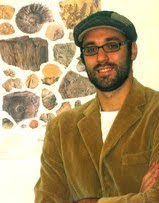Geological objects extend over a wide scale range: from tectonic plates to mountains, from glaciers to sand grains. Intriguingly, distant scale ranges are often interconnected and the same phenomenon can hold on very different scales. In order to explain this concept, I invite you to a relay race through orders of scale.
Variations in the Earth's orbit change the amount of solar radiation reaching the Earth. At the same time, the motion of tectonic plates reconfigures Earth's topography, consequently affecting both global and local patterns of atmosphere-ocean circulation. Plate tectonics influence also volcanic emissions (gases and particulates), which have a significant climate-controlling role.
These (and many other) elements shape the Earth's climate, including ocean temperature and marine currents, which controls the distribution of marine microorganisms.
From 150 million kilometers (Earth-Sun distance) to half a millimeter.
From 150 million kilometers (Earth-Sun distance) to half a millimeter.
Conversely, variation in the ancient Earth's orbit can be figured out from fossils smaller than a sand grain. Likewise, microfossils are used to reconstruct past climate, ocean currents and sea depth.
One of the most important groups of microfossils are Foraminifera ('forams', for friends). They are a large group of unicellular organisms with fine strands of cytoplasm that branch and merge to form a dynamic net. They typically produce a test, or shell, which is often preserved in marine sediments.
Geologists usually study forams through a microscope and obtain information from their complex morphology. The shape of Foraminifera already captivated the artistic talent of Earnst Haeckel, who depicted several specimens in his “Artforms of Nature”.
One of the most important groups of microfossils are Foraminifera ('forams', for friends). They are a large group of unicellular organisms with fine strands of cytoplasm that branch and merge to form a dynamic net. They typically produce a test, or shell, which is often preserved in marine sediments.
Geologists usually study forams through a microscope and obtain information from their complex morphology. The shape of Foraminifera already captivated the artistic talent of Earnst Haeckel, who depicted several specimens in his “Artforms of Nature”.
 | ||
| Foraminifera in Ernst Haeckel's Artforms of Nature. |
Recently, the morphology of Foraminifera became the key point of a sculpture garden: the Foraminiferal Sculpture Park in Zhongsham, China. The Zhongsham park is the world's first park dedicated to Foraminifera. It hosts sculptures of Paleozoic to modern species, carved out of marble, granite and sandstone.
 |
| The Foraminiferal Sculpture Park of Zhongsham (China). From the website of the Cushman foundation. |
A question might arise: How did the Foraminiferal Sculpture Park come to light?
The answer is given by the Cushman Foundation, one of the world's leading micropaleontological associations:
“The germ of an idea for a sculpture park first began some ten years earlier when marine geologist Bilal Haq of the National Science Foundation visited the lab of marine biologist and academician Zheng Shouyi at the Institute the Institute of Oceanology in Qingdao”
Indeed Zheng Shouyi, one of the world’s leading foraminiferalogists, sculpted palm-size models of over a hundred of Foraminifera for educational purposes. She enlarged the tridimensional morphology of microfossils by sculpture, in order to render their form – otherwise indistinguishable to the human eye.
The answer is given by the Cushman Foundation, one of the world's leading micropaleontological associations:
“The germ of an idea for a sculpture park first began some ten years earlier when marine geologist Bilal Haq of the National Science Foundation visited the lab of marine biologist and academician Zheng Shouyi at the Institute the Institute of Oceanology in Qingdao”
Indeed Zheng Shouyi, one of the world’s leading foraminiferalogists, sculpted palm-size models of over a hundred of Foraminifera for educational purposes. She enlarged the tridimensional morphology of microfossils by sculpture, in order to render their form – otherwise indistinguishable to the human eye.
 |
| Walking between gigant forams: this is possible at the Zhongsham Foraminiferal park! Image from Nfdaily. |
 |
| A variety of the sculpted forams. Image from www.ccdu.cn. |
Bilal Haq, admiring the abstract and organic beauty of these models, proposed to Zheng to enlarge the sculptures. As reported by the Cushman foundation, “Zheng, a woman of action and a politically influential scientist, took the suggestion seriously” and supervised local artisans for a period of over five years.
The result of this elaborate creative process is breath-taking: 114 permanently-sited sculptures in landscaped surroundings, covering a time span from Paleozoic to recent times. The Foraminiferal Sculpture Park in Zhongsham is an astounding celebration of biological diversity through geological time.
True Artforms of Nature, in the best Haeckel's tradition.
The result of this elaborate creative process is breath-taking: 114 permanently-sited sculptures in landscaped surroundings, covering a time span from Paleozoic to recent times. The Foraminiferal Sculpture Park in Zhongsham is an astounding celebration of biological diversity through geological time.
True Artforms of Nature, in the best Haeckel's tradition.
 |
| Interpretative structures corroborates the artistic experience. From the website of the Cushman foundation. |
 |
| Art is a great opportunity for scientific entertainment and geotourism! |
 |
| More micropaleontologic art. From deltabridges.com |







No comments:
Post a Comment